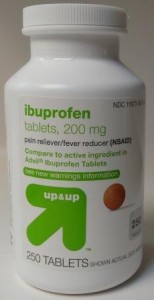How anti-inflammatory drugs work and a better way to reduce pain
 Anti-inflammatory drugs such as aspirin, NSAIDS (non-steroidal anti-inflammatory drugs), and steroids reduce pain and inflammation primarily by blocking normal prostaglandin function. Prostaglandins are hormone-like substances necessary to normal body processes.
Anti-inflammatory drugs such as aspirin, NSAIDS (non-steroidal anti-inflammatory drugs), and steroids reduce pain and inflammation primarily by blocking normal prostaglandin function. Prostaglandins are hormone-like substances necessary to normal body processes.
There are three groups of prostaglandins: two of them, prostaglandin-1 (PG1) and prostaglandin-3 (PG3) are anti-inflammatory. The third, prostaglandin-2 (PG2) is inflammatory. All three are necessary for multiple functions in the body. Production of PG2 is part of the body’s response to a need for repair, healing, and maintaining homeostasis in the body. Inflammation is a normal part of that response; however, there is often pain and discomfort associated with the inflammation. Aspirin, other NSAIDS, and steroids are routinely prescribed to reduce the pain and inflammation even though suppression of PG2 production may delay or prevent the healing process. These drugs block the normal prostaglandin function by inhibiting the process of converting the essential fatty acid arachadonic acid, through enzymatic actions, into PG2, thus suppressing pain and inflammation.
Although the delay or prevention of healing through PG2 suppression is a serious consequence of using steroids and NSAIDS, the side effects of the drugs can cause even worse problems, including gastrointestinal bleeding and renal failure. The side effects of anti-inflammatory drugs are estimated to cause thousands of deaths and hospitalizations each year.
Often, excessive inflammatory response is the result of an imbalance between omega 3 and omega 6 fatty acid intake. A better response to pain and inflammation could be to regulate the balance of these two types of fatty acids, which, in the typical American diet, usually requires increasing the omega 3’s and reducing the omega 6’s. At least it would be healthier to try to improve fatty acid balance before taking drugs that have the potential to cause serious side effects.
Some common brand names of NSAIDs are Anacin, Bayer, Ecotrin, Celebrex, Advil, Motrin, Naprosyn, and Vioxx. Generic names of NSAIDS include aspirin, ibuprofen, colecoxib, naproxen, and rofecoxib.
This post is based on a homework essay for my course work with the Nutritional Therapy Association’s Nutritional Therapist program.
Sources for more information about inflammation and anti-inflammatory drugs:
Non-steroidal anti-inflammatory drug
NSAIDs Side Effects
Are Anti-Inflammatory Pain Relievers Safe for You?
List of NSAIDs
What Is Inflammation? What Causes Inflammation?
What is inflammation?
Prostaglandin
This post is shared on Freaky Friday.

Comments
How anti-inflammatory drugs work and a better way to reduce pain — No Comments
HTML tags allowed in your comment: <a href="" title=""> <abbr title=""> <acronym title=""> <b> <blockquote cite=""> <cite> <code> <del datetime=""> <em> <i> <q cite=""> <s> <strike> <strong>